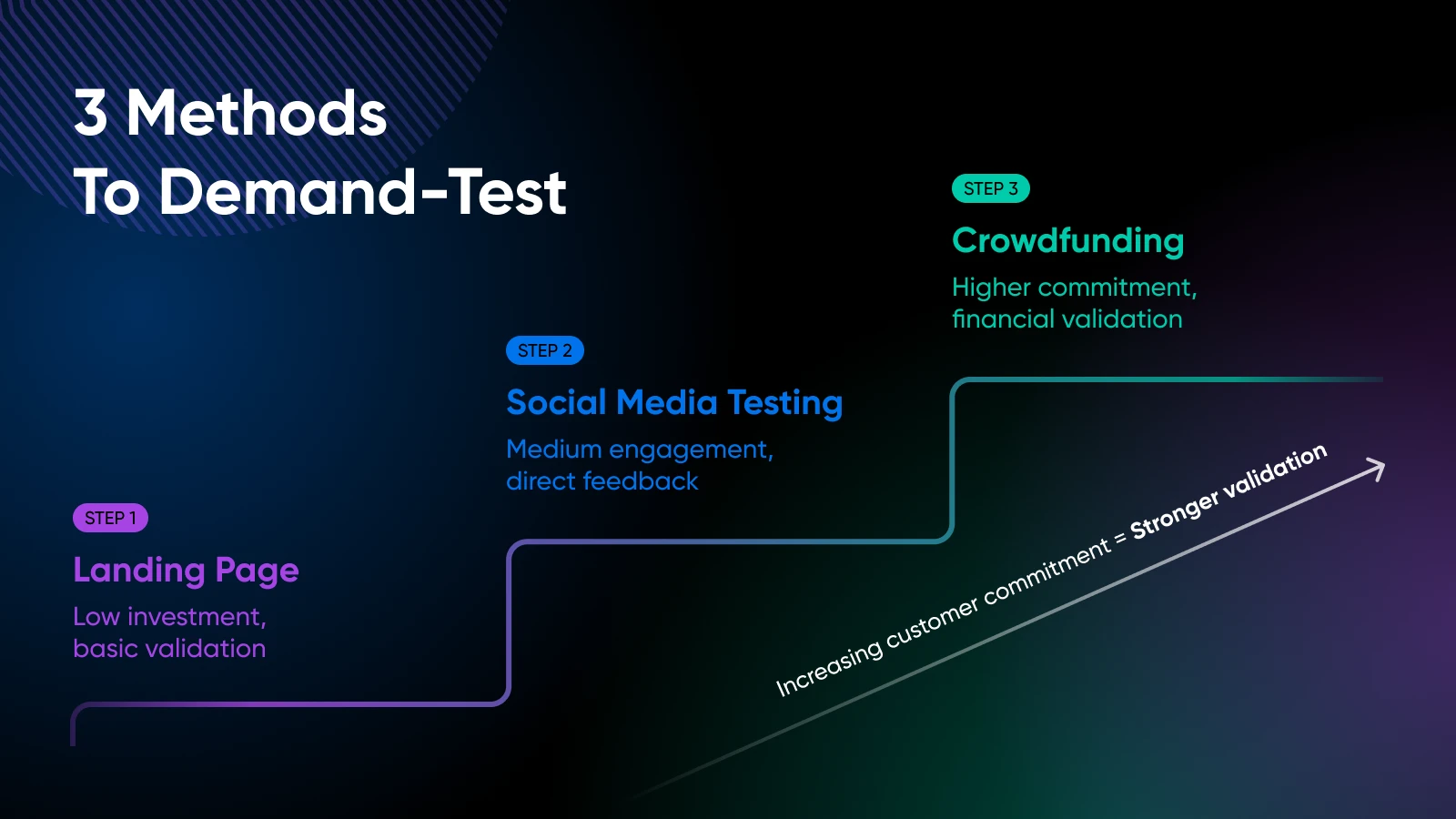Ever daydreamed about turning your passion for baking, knitting, or web design into a money-making venture? Or maybe you’ve already tried out a side hustle idea or two — from dog walking to online tutoring — and still haven’t pinned down the one that feels right.
Most side hustles fizzle out or fail — not because the founder wasn’t talented or motivated, but because they never tested if anyone actually wants what they’re offering. Earrings made out of cat teeth? Definitely very cool to some people. But enough people to sustain a whole business? That’s the million-dollar question.
And this is where validation comes in. By road-testing your business idea, you can find out if there’s real demand — enough to sustain your side hustle. Plus, gather honest feedback and avoid throwing time and cash down the drain.
In this guide, you’ll learn how to identify a genuine market need, find the folks who’ll pay you to solve it, and test your idea without going broke on inventory, equipment, or marketing.
Ready to see if your big idea has legs? Let’s jump in.
Step 1: Don’t Chase Trends — Focus on Solving a Real Problem
It can be tempting to hop on the latest trend when you’re starting a business. After all, who wants to miss the next big wave of “must-have” products? But chasing fads can backfire quickly. By the time you’ve launched, the market may have already moved on. Instead, target a lasting problem or need that makes people’s lives easier.

How To Spot Real Problems
One of the best ways to uncover genuine pain points is by digging into online communities, forums, and review sites. For example, try:
- Reddit or Facebook groups – Join groups related to your interests. If you’re into handmade crafts, look for art or DIY communities. Pay attention to recurring complaints or requests.
- Review sites – Browse negative reviews for products in your niche. If many people gripe about the same flaw, that’s a potential opening for you to create a better solution.
- Real conversations – Chat with friends, colleagues, or even random acquaintances. Ask, “What’s your biggest frustration with X?” Sometimes, just listening leads to insights you won’t find online.
When you solve a real problem, people take notice. They’re more willing to pay for something that genuinely helps them or saves them time. So before you fixate on the next shiny social media trend, do a little digging into what folks around you truly need. A problem-first approach provides a solid foundation for your side hustle.
Step 2: Find (and Engage) Your Target Audience
You might be itching to design logos for local businesses, but if you don’t connect with actual local business owners, you’re only guessing at what they want. To make sure your idea has legs, you need to figure out who will use your product or service and why.
How To Do It
- Define your ideal customer: Spend a few minutes brainstorming who your dream customer is. How old are they? What’s their lifestyle like? What’s their monthly budget for the problem you’re trying to solve? Getting specific can help you market your business more effectively.
- Ask for direct feedback: Some good places to do this include:
- Social media polls: Post a simple yes/no or multiple-choice poll on Twitter or Instagram Stories. See how many people express interest in your idea.
- Online communities: Sites like Quora, Facebook groups, or subreddits relevant to your business are goldmines for honest feedback. Drop a question about your side hustle concept (for example, “Would you pay for a weekly dinner kit that’s fully organic?”) and wait for responses to roll in.
- One-on-one chats: Virtual coffee chats or DMs can uncover details and color a poll might miss. Encourage open-ended feedback like “Tell me more about what frustrates you” to get deeper insights.
- Segment early and segment often: As you gather feedback, you might notice distinct subgroups forming. For example, if you’re launching a healthy meal prep service, you could end up with “busy parents” who want quick dinners and “fitness buffs” who need high-protein meals. Keep track of segments that form naturally, because you’ll tailor future communication and products to each group.
Finding your audience is like detective work — it takes time, observation, and a lot of listening. But the payoff is huge: you’ll develop a clearer picture of who you’re serving and how to speak their language. Once you’ve nailed that down, it’s time to see if your idea holds water in the real world.
Step 3: Test Demand with a Low- or No-Cost MVP
MVP stands for “minimum viable product.” Think of it as the most stripped-down version of your offering, designed to validate your assumptions about your business idea. Instead of pouring money into inventory or a fancy website, start small. You’ll see if people are interested in your business, product, or idea — without risking your life’s savings.
3 Ways To Demand-Test Your MVP
- Create a landing page with a waitlist: Create a simple, one-page website describing your future product or service. Add a button or form inviting users to “Join the Waitlist” or “Sign Up for Updates.” Services like WordPress (hosted on DreamHost, naturally) or a quick landing page builder can help you get this live in under an hour.
- Use social media to ask for beta testers: Let’s say you’re launching a new design template shop. Post a teaser on Instagram or TikTok asking for beta testers. If you get a flood of excited comments or DMs, that’s a strong sign you’re onto something.
- Crowdfund your idea: If you’re confident in your pitch, consider a small crowdfunding campaign to gauge enthusiasm. Keep the funding goal modest so you know if backers are genuinely excited or if they’re just curious.

An MVP lets you dip your toes in the market waters. If nobody bites on your waitlist or social media post, you’ve saved yourself a lot of cash — and heartbreak. On the other hand, an enthusiastic response proves there’s a real audience for your idea, setting you up to launch your business with more confidence.
Step 4: Gauge Real Interest with Pre-Sales (or a “Soft Launch”)
If your MVP indicates that people like your concept, consider opening up pre-orders. This can be as simple as a PayPal link or a form on your website. If folks actually pull out their credit cards, you have genuine evidence of demand.
Here are some quick, easy ways you can softly launch your product or business idea:
- Offer limited early bird pricing – Offer a discount for the first batch of orders to reward your earliest fans.
- Create a referral incentive – Ask early buyers if they’ll share a link with friends. Word-of-mouth validation is incredibly powerful.
It’s one thing for someone to say, “That sounds cool!” It’s another for them to actually invest. Whether it’s a $5 deposit or a full upfront purchase, money on the table is the clearest sign you’re solving a problem people care about.
Step 5: Tweak, Pivot, or Move On
By now, you’ve gathered a lot of data: poll responses, waitlist sign-ups, and maybe even some pre-sales. Step back and ask yourself these questions.
Was There Sufficient Interest?
If you only got a handful of sign-ups, is that because your marketing outreach was small, or because the idea isn’t landing?
What Did Early Users Say?
Did you receive consistent feedback on your pricing, features, or design choices?
Is the Timing Right?
Maybe your idea is solid, but you need to delay or rework certain elements.
Making Adjustments
Don’t be afraid to iterate. If the feedback suggests people love the concept but hate the price, experiment with different pricing tiers. If they want more colors, designs, or package options, incorporate that into your next test.
Not every idea will become the next breakout success. If you’ve iterated a few times and still see minimal engagement, it might be time to shelve this project. That’s okay! You saved yourself a ton of stress and money by testing early. And who knows? A new idea might emerge from what you learned.

Start Small, Validate, and Launch With Confidence
Building a profitable side hustle isn’t just about dreaming big — it’s about testing your assumptions in the real world. When you solve a genuine problem, connect with the people experiencing it, and gather proof of demand, you’re setting yourself up for success from the get-go.
What to do next:
- Identify a real need – Skip the fads; dig deep into problems people actually have.
- Talk to your audience – Social polls, online forums, direct chats — the more feedback, the better.
- Experiment with your MVP – Launch a landing page or a small beta test. Watch how people respond.
- Confirm with pre-sales – A deposit or payment is the strongest “Yes!” you can get to validate your idea.
- Adjust or pivot – Use your results to refine your idea or, if necessary, move on to something new.
And remember: you don’t have to be a tech genius or a marketing guru to pull any of this off. If you need a quick way to spin up a landing page or web presence, DreamHost is here to help with reliable, easy-to-use hosting solutions. We love seeing side hustlers go from idea to thriving business — and we’re excited to help you make that journey, step by step.

Your Great Idea Starts with a Domain Name
A custom domain gives your site a professional look, strengthens your brand, and helps visitors find you on the web.
Did you enjoy this article?

